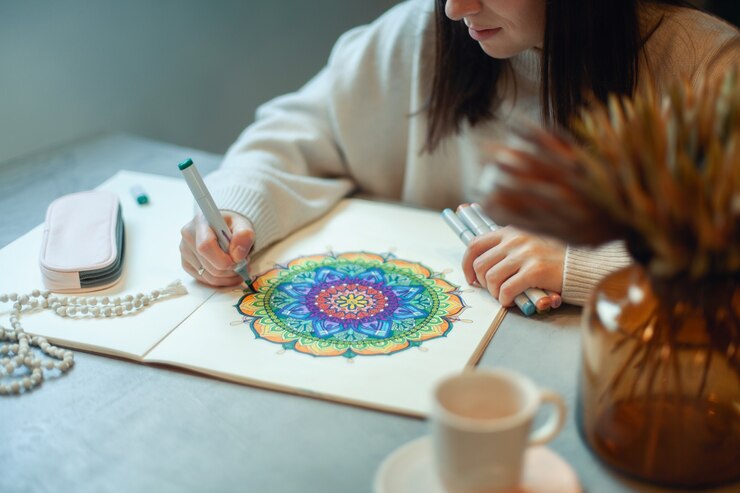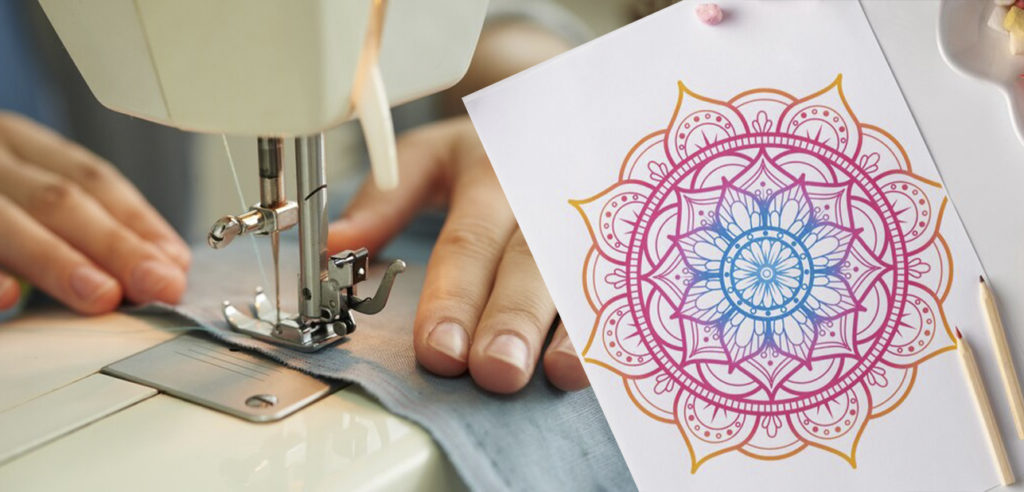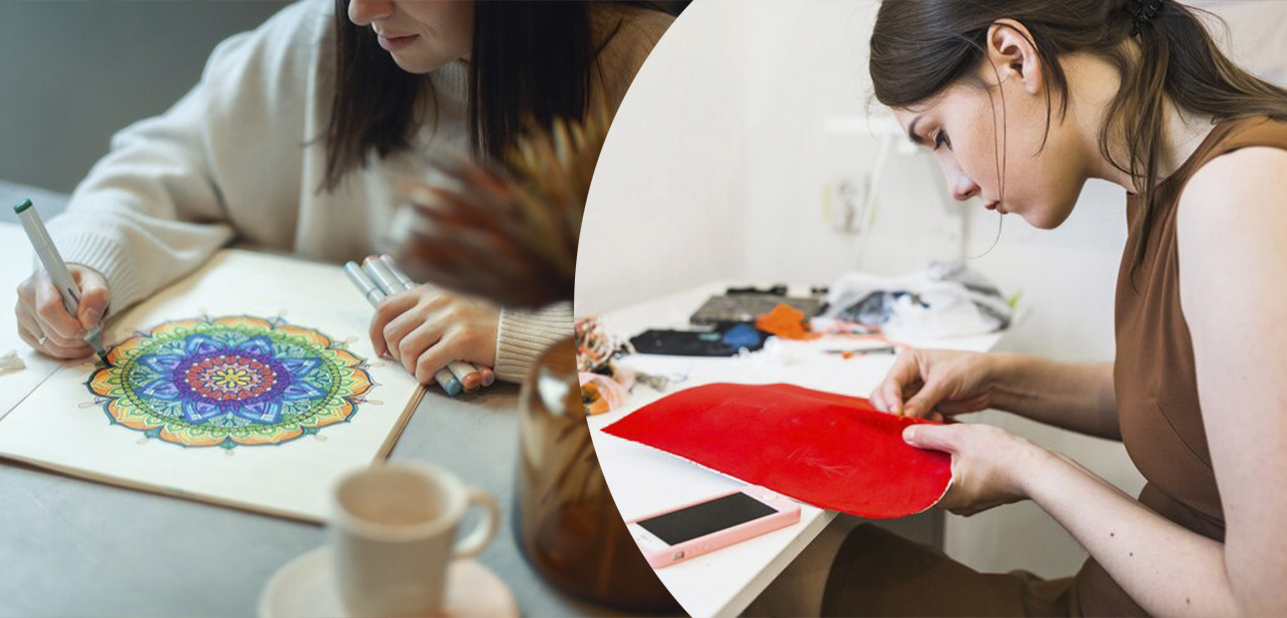Do you want to try a therapeutic hobby? Quilting might be for you! Mandala quilts aren’t just pretty to look at; they let you express yourself better. As you stitch together these intricate designs, you’ll discover a meditative practice that unlocks new depths of creativity.
Whether you’re a seasoned quilter or a beginner, we invite you to connect with your inner artist. Let’s explore how mandala quilts can transform your living space and nurture your soul.
What is a Mandala?
Do you know those beautiful, circular patterns called mandalas? They’ve been around for ages, popping up in cultures all over the world. In many spiritual traditions, mandalas serve as visual tools for meditation, guiding individuals toward inner peace and spiritual growth.



The Role of Sacred Geometry
Sacred geometry, often called the “blueprint of the universe,” is important in mandala quilt design. These patterns exist in nature and have been used by cultures around the world for centuries. They represent basic mathematical principles and proportions that we find naturally pleasing. By adding these patterns to our quilts, we tap into something bigger than ourselves, the forces that shape our world.
What are Mandala Quilts?
When we bring mandalas into quilting, we blend artistry and mindfulness. The repetitive stitching, the careful selection of colors, and the harmonious arrangement of patterns all contribute to a meditative experience.
When you use sacred geometry in your quilt designs, it gives your work a deeper meaning. It links your quilt to the patterns found throughout the world, showing how everything is connected. Your quilt becomes more than just fabric and thread; it’s a reminder of how we’re all part of something bigger.

The Therapeutic Benefits of Mandala Quilts
Quilting mandala patterns also bring therapeutic benefits that nourish your mind and spirit.
Stress Relief and Relaxation through Quilting
The repetitive nature of quilting, combined with the focus on intricate patterns, creates a meditative state. As you stitch each piece together, your mind quiets, and a sense of calm washes over you. It’s a chance to disconnect from the hustle and bustle of daily life and reconnect with yourself.

Boost Your Focus and Concentration
Creating mandala quilts also sharpens your focus and concentration. As you carefully select fabrics, cut shapes, and piece them together, your mind becomes fully absorbed in the task. This focused attention not only enhances your quilting skills but also cultivates mindfulness.
Express Yourself and Discover More About You
Mandala quilts are also an avenue for creative expression and self-discovery. The choices you make—from the colors you select to the patterns you incorporate—reflect your personality and style. As you work, you may find yourself exploring new ideas, tapping into your intuition, and discovering hidden aspects of yourself.
Get Started with Your Mandala Quilt Project



Ready to create your mandala quilt? Let’s gather what you need and prepare for a creative and mindful experience.
- 1. Choose Your Pattern
If you’re new to mandala quilting, start with a simple pattern to build confidence. Look for geometric shapes and repeating motifs that are easy to cut and sew. As you gain experience, explore more intricate designs. There are many resources online and in quilting books to inspire you.
- 2. Select Your Fabrics and Colors
Now for the fun part: choosing your fabrics and colors! Think about the mood you want to create with your quilt. Do you want calming cool colors or vibrant warm colors? Consider how the colors will complement your home decor and evoke your emotions.
Don’t limit yourself to solid fabrics. Experiment with batiks, hand-dyed fabrics, and silks for added texture and visual interest. Vary the scale of your prints, using smaller designs for intricate sections and larger ones for backgrounds or borders.
- 3. Gather Your Tools and Materials
Before you start stitching, gather all the necessary tools and materials. You’ll need a sewing machine, rotary cutter, quilting ruler, fabric scissors, thread, batting, and a comfortable workspace with ample lighting.
Remember, quilting is not a race. Take your time, enjoy the process, and let your creativity flow. With the right tools, fabrics, and a dash of inspiration, you’ll be creating a beautiful mandala quilt.
Step-by-Step Guide to Making a Mandala Quilt
Ready to start stitching? Let’s break down the process of creating your mandala quilt into easy-to-follow steps.
- Step 1: Prepare Your Workspace
First, create a calm and inviting space where you can focus on your project. Clear a table or designate a quilting area with good lighting. Make sure you have enough space to spread out your fabrics and tools. You can even put on some relaxing music or nature sounds to enhance the atmosphere and set the mood for mindful crafting.
- Step 2: Cut and Piece Your Quilt Top
If you’re using a pre-cut kit, follow the instructions. If not, carefully cut out each piece of fabric according to your pattern. Ensure accuracy to maintain the mandala’s symmetry. Start by sewing the center of your mandala, then add the surrounding pieces, working outward. Use a consistent seam allowance and press your seams open for a smooth finish.
Tip: Use a rotary cutter and ruler for precise cuts. A walking foot on your sewing machine can help you sew through multiple layers of fabric smoothly.
- Step 3: Quilt Your Mandala
Once your quilt top is complete, you can add texture and dimension through quilting. Whether you prefer hand quilting or machine quilting, choose a technique you’re comfortable with. For beginners, simple straight lines or a basic stippling pattern can add depth. More experienced quilters may explore free-motion quilting for greater creativity and intricate patterns.
Quilting Techniques to Try:
- Straight Line Quilting: A simple yet effective way to add texture and define shapes.
- Stippling: A free-motion technique that creates a textured, pebbled effect.
- Echo Quilting: Follow the contours of your pieced shapes with stitching lines.
- Free-Motion Quilting: Explore intricate designs and patterns with free-motion stitching.
- Step 4: Add the Finishing Touches
The final step is adding the finishing touches. Binding your quilt gives it a polished look and adds durability. Choose a binding fabric that compliments your design and sew it around the edges. You can also add embellishments like beads, embroidery, or appliqué to personalize your creation.


Display Your Mandala Quilts at Home
Hang your mandala quilt on a wall as a stunning focal point. It can instantly transform a blank wall into a gallery of textile artistry. Choose a location with good natural light to showcase the vibrant colors and patterns. You can even create a dedicated quilting corner to display your mandala alongside other quilted creations or art pieces.
For a more functional approach, use your mandala quilt as a throw blanket for your sofa or bed. Its intricate design and soft textures will add warmth and comfort to your living space.
Resources for Your Mandala Quilting Project
Whether you’re a beginner or a seasoned quilter, there’s a mandala quilt pattern perfect for you. From simple geometric designs to intricate patterns, the options are endless.
If you want to refine your technique, consider a quilting course or workshop. We have online classes and art workshops for all skill levels. Whether you want to master free-motion quilting, learn advanced piecing techniques, or explore color theory, these courses will elevate your quilting practice.
Nurture Your Creative Spirit with Mandala Quilts
The rhythmic movement of the needle, the careful selection of fabrics, and the creation of intricate patterns contribute to the meditative experience of mandala quilting. Each mandala quilt you create is unique. It’s a reflection of your inner world, a tangible representation of your creativity and mindfulness.
Whether you display it proudly in your home, gift it to a loved one, or share it with the world, it will be a reminder of the beauty that emerges when you combine creativity and mindfulness. So, continue to explore mandala quilting, find joy in the process, and discover a new passion for mandala quilts.


